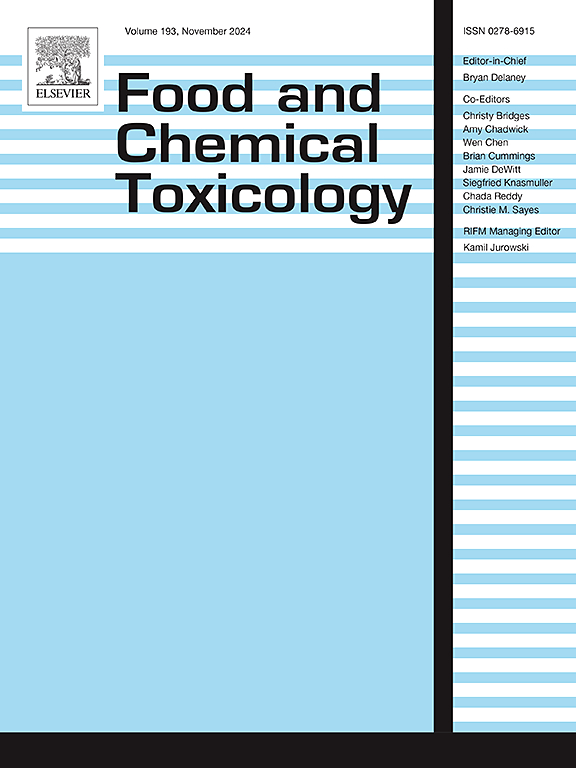膳食中摄入充足的必需 n-3 脂肪酸(α-亚麻酸)可部分改善心脏氧脂对 2-一氯丙烷-1,3-二醇暴露的扰动。
IF 3.9
3区 医学
Q2 FOOD SCIENCE & TECHNOLOGY
引用次数: 0
摘要
2- 氯丙二醇(2-MCPD)是一种食品污染物,对大鼠具有心脏毒性。这种不良影响与 F344 大鼠体内抗炎性较低的二十二碳六烯酸(DHA)衍生的心脏氧脂有关。因此,我们研究了α-亚麻酸(ALA)(一种必需的 n-3 多不饱和脂肪酸(PUFA))不足(0.07 克/100 克膳食)或充足(0.5 克/100 克膳食)是否会改变暴露于 50 毫克 2-MCPD/kg 体重/天的 Sprague-Dawley 大鼠心脏、肝脏、肾脏和血清中的氧脂反应。ALA 增加了所有组织中的 n-3 氧脂素,反映了更多的 n-3 PUFA 底物可用性。在心脏中,2-氯丙二醇增加了环氧合酶衍生的花生四烯酸氧脂,从而导致炎症。充足的 ALA 膳食显示,2-氯丙二醇诱导的抗炎性心脏 DHA 衍生氧脂减少;在 ALA 缺乏的膳食中,这种情况并不明显,因为这些 n-3 PUFA 氧脂已经减少。相反,2-氯丙二醇会增加心脏 13-羟基-十八碳三烯酸-γ(13-HOTrE-γ)的水平,而缺乏 ALA 的膳食则不会。多组织分析确定 13-HOTrE-γ 是暴露于 2-MCPD 的标志物。我们的研究为 2-MCPD 的毒性提供了有力的证据,证实了氧化脂在心脏中的功能性和指示性作用,并表明对化学危害的研究应使用充足的 n-3 PUFA 膳食。本文章由计算机程序翻译,如有差异,请以英文原文为准。
Cardiac oxylipin perturbances in response to 2-monochloropropane-1,3-diol exposure are ameliorated by dietary adequacy of the essential n-3 fatty acid, α-linolenic acid
2-Monochloropropane-1,3-diol (2-MCPD) is a food contaminant with demonstrated cardiotoxicity in rats. This adverse effect was previously associated with lower anti-inflammatory docosahexaenoic acid (DHA)-derived cardiac oxylipins in F344 rats. This previous study utilized corn oil as the dietary lipid; we therefore investigated whether deficient (0.07 g/100 g diet) or adequate (0.5 g/100 g diet) dietary α-linolenic acid (ALA), the essential n-3 polyunsaturated fatty acid (PUFA), alters the oxylipin response in heart, liver, kidney, and serum of Sprague-Dawley rats exposed to 50 mg 2-MCPD/kg BW/day. ALA increased n-3 oxylipins in all tissues, reflecting greater n-3 PUFA substrate availability. In the heart, 2-MCPD increased cyclooxygenase-derived arachidonic acid oxylipins, conducive to inflammation. Adequate dietary ALA revealed 2-MCPD-induced reductions of anti-inflammatory cardiac DHA-derived oxylipins; these were not apparent in the ALA-deficient diet as these n-3 PUFA oxylipins were already reduced. Conversely, 2-MCPD increased cardiac 13-hydroxy-octadecatrienoic acid-γ (13-HOTrE-γ) levels with deficient, but not adequate, ALA diets. Multi-tissue analysis identified 13-HOTrE-γ as a marker of 2-MCPD exposure. Our study contributes to the weight-of-evidence of 2-MCPD toxicity, confirms the functional and indicative roles of oxylipins in the heart, and demonstrates that live bioassays determining chemical health hazards should use adequate n-3 PUFA diets.
求助全文
通过发布文献求助,成功后即可免费获取论文全文。
去求助
来源期刊

Food and Chemical Toxicology
工程技术-毒理学
CiteScore
10.90
自引率
4.70%
发文量
651
审稿时长
31 days
期刊介绍:
Food and Chemical Toxicology (FCT), an internationally renowned journal, that publishes original research articles and reviews on toxic effects, in animals and humans, of natural or synthetic chemicals occurring in the human environment with particular emphasis on food, drugs, and chemicals, including agricultural and industrial safety, and consumer product safety. Areas such as safety evaluation of novel foods and ingredients, biotechnologically-derived products, and nanomaterials are included in the scope of the journal. FCT also encourages submission of papers on inter-relationships between nutrition and toxicology and on in vitro techniques, particularly those fostering the 3 Rs.
The principal aim of the journal is to publish high impact, scholarly work and to serve as a multidisciplinary forum for research in toxicology. Papers submitted will be judged on the basis of scientific originality and contribution to the field, quality and subject matter. Studies should address at least one of the following:
-Adverse physiological/biochemical, or pathological changes induced by specific defined substances
-New techniques for assessing potential toxicity, including molecular biology
-Mechanisms underlying toxic phenomena
-Toxicological examinations of specific chemicals or consumer products, both those showing adverse effects and those demonstrating safety, that meet current standards of scientific acceptability.
Authors must clearly and briefly identify what novel toxic effect (s) or toxic mechanism (s) of the chemical are being reported and what their significance is in the abstract. Furthermore, sufficient doses should be included in order to provide information on NOAEL/LOAEL values.
 求助内容:
求助内容: 应助结果提醒方式:
应助结果提醒方式:


